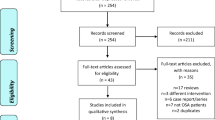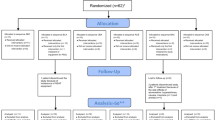Abstract
Purpose
Although there is a high co-occurrence of insomnia and obstructive sleep apnea (OSA), the administration of sedative hypnotics in patients with OSA is still inconsistent. The aim is to study the effect of non-benzodiazepine hypnotics (non-BZDs) on sleep quality and severity in patients with OSA.
Methods
We conducted a systemic search for controlled clinical trials in multiple databases and pooled analysis of the impact of non-BZDs on objective sleep quality and the severity of OSA, including the apnea-hypopnea index (AHI) and mean and nadir arterial oxygen saturation (SaO2) in patients with OSA. Sensitivity analysis was carried out to explore the robustness of results.
Results
Eight relevant placebo-controlled clinical trials involving 448 patients were included. Objective sleep quality, including sleep latency, sleep efficiency, and wake time after sleep onset, was significantly improved in patients taking non-BZDs compared with those taking placebo (p < 0.01). The weighted estimate indicated that the administration of non-BZDs prior to bedtime had no significant effect on AHI or SaO2 in OSA patients (p > 0.05).
Conclusions
The administration of non-BZDs at the commonly recommended dose has been shown to improve objective sleep quality in OSA patients without worsening sleep apnea. It suggests that OSA patients with a complaint of insomnia symptoms may benefit from taking non-BZDs.









Similar content being viewed by others
References
Luyster FS, Buysse DJ, Strollo PJ Jr (2010) Comorbid insomnia and obstructive sleep apnea: challenges for clinical practice and research. J Clin Sleep Med 6:196–204
Sivertsen B, Overland S, Glozier N, Bjorvatn B, Maeland JG, Mykletun A (2008) The effect of OSAS on sick leave and work disability. Eur Respir J 32:497–503
Krell SB, Kapur VK (2005) Insomnia complaints in patients evaluated for obstructive sleep apnea. Sleep Breath 9:104–110
Thurnheer R (2011) Diagnostic approach to sleep-disordered breathing. Expert Rev Respir Med 5:573–589
Drake CL, Day R, Hudgel D, Stefadu Y, Parks M, Syron ML et al (2003) Sleep during titration predicts continuous positive airway pressure compliance. Sleep 26:308–311
Lettieri CJ, Shah AA, Holley AB, Kelly WF, Chang AS, Roop SA et al (2009) Effects of a short course of eszopiclone on continuous positive airway pressure adherence: a randomized trial. Ann Intern Med 151:696–702
Pinto LR Jr, Alves RC, Caixeta E, Fontenelle JA, Bacellar A, Poyares D et al (2010) New guidelines for diagnosis and treatment of insomnia. Arq Neuropsiquiatr 68:666–675
Hanly P, Powles P (1993) Hypnotics should never be used in patients with sleep apnea. J Psychosom Res 37(Suppl 1):59–65
Dolly FR, Block AJ (1982) Effect of flurazepam on sleep-disordered breathing and nocturnal oxygen desaturation in asymptomatic subjects. Am J Med 73:239–243
Bezel R, Russi E, Kronauer H, Mothersill I (1987) Life-threatening apnea after midazolam administration in a patient with obstructive sleep apnea syndrome. Schweiz Med Wochenschr 117:579–583
Cirignotta F, Mondini S, Zucconi M, Gerardi R, Farolfi A, Lugaresi E (1988) Zolpidem-polysomnographic study of the effect of a new hypnotic drug in sleep apnea syndrome. Pharmacol Biochem Behav 29:807–809
Coyle MA, Mendelson WB, Derchak PA, James SP, Wilson MG (2005) Ventilatory safety of zaleplon during sleep in patients with obstructive sleep apnea on continuous positive airway pressure [Letter]. J Clin Sleep Med 1:97
Lettieri CJ, Collen JF, Eliasson AH, Quast TM (2009) Sedative use during continuous positive airway pressure titration improves subsequent compliance: a randomized, double-blind, placebo-controlled trial. Chest 136:1263–1268
Eckert DJ, Owens RL, Kehlmann GB, Wellman A, Rahangdale S, Yim-Yeh S et al (2011) Eszopiclone increases the respiratory arousal threshold and lowers the apnoea/hypopnoea index in obstructive sleep apnoea patients with a low arousal threshold. Clin Sci (Lond) 120:505–514
George CF, Feldman N, Inhaber N, Steininger TL, Grzeschik SM, Lai C et al (2010) A safety trial of sodium oxybate in patients with obstructive sleep apnea: acute effects on sleep-disordered breathing. Sleep Med 11:38–42
Lettieri CJ, Quast TN, Eliasson AH, Andrada T (2008) Eszopiclone improves overnight polysomnography and continuous positive airway pressure titration: a prospective, randomized, placebo-controlled trial. Sleep 31:1310–1316
Rosenberg R, Roach JM, Scharf M, Amato DA (2007) A pilot study evaluating acute use of eszopiclone in patients with mild to moderate obstructive sleep apnea syndrome. Sleep Med 8:464–470
Berry RB, Patel PB (2006) Effect of zolpidem on the efficacy of continuous positive airway pressure as treatment for obstructive sleep apnea. Sleep 29:1052–1056
Zucconi M, Ferini-Strambi L, Palazzi S, Orena C, Zonta S, Smirne S (1992) Habitual snoring with and without obstructive sleep apnoea: the importance of cephalometric variables. Thorax 47:157–161
Sato R, Malish S, Dickel GD, Hungs M, Sassoon C (2010) Hypnotics fail to improve polysomnographic quality and efficacy of CPAP titration [Abstract]. Chest 138:701A
Park JG, Olson EJ, Morgenthaler TI (2013) Impact of zaleplon on continuous positive airway pressure therapy compliance. J Clin Sleep Med 9:439–444
Collen J, Lettieri C, Kelly W, Roop S (2009) Clinical and polysomnographic predictors of short-term continuous positive airway pressure compliance. Chest 135:704–709
Bradshaw DA, Ruff GA, Murphy DP (2006) An oral hypnotic medication does not improve continuous positive airway pressure compliance in men with obstructive sleep apnea. Chest 130:1369–1376
Guilleminault C, Eldridge FL, Dement WC (1973) Insomnia with sleep apnea: a new syndrome. Science 181:856–858
Björnsdóttir E, Janson C, Gíslason T, Sigurdsson JF, Pack AI, Gehrman P, Benediktsdóttir B (2012) Insomnia in untreated sleep apnea patients compared to controls. J Sleep Res 21:131–138
Sériès F, Roy N, Marc I (1994) Effects of sleep deprivation and sleep fragmentation on upper airway collapsibility in normal subjects. Am J Respir Crit Care Med 150:481–485
Crestani F, Löw K, Keist R, Mandelli M, Möhler H, Rudolph U (2001) Molecular targets for the myorelaxant action of diazepam. Mol Pharmacol 59:442–445
Hajak G, Cluydts R, Declerck A, Estivill SE, Middleton A, Sonka K, Unden M (2001) Continuous versus non-nightly use of zolpidem in chronic insomnia: results of a large-scale, double-blind, randomized, outpatient study. Int Clin Psychopharmacol 17:9–17
Roth T, Walsh JK, Krystal A, Wessel T, Roehrs TA (2005) An evaluation of the efficacy and safety of eszopiclone over 12 months in patients with chronic primary insomnia. Sleep Med 6:487–495
Israel AG, Kramer JA (2002) Safety of zaleplon in the treatment of insomnia. Ann Pharmacother 36:852–859
Beaumont M, Batéjat D, Piérard C, Van Beers P, Philippe M, Léger D et al (2007) Zaleplon and zolpidem objectively alleviate sleep disturbances in mountaineers at a 3,613 meter altitude. Sleep 30:1527–1533
Girault C, Muir JF, Mihaltan F, Borderies P, Borderies P, De La Giclais B, Verdure A et al (1996) Effects of repeated administration of zolpidem on sleep, diurnal and nocturnal respiratory function, vigilance, and physical performance in patients with COPD. Chest 110:1203–1211
Quadri S, Drake C, Hudgel DW (2009) Improvement of idiopathic central sleep apnea with zolpidem. J Clin Sleep Med 5:122–129
Walsh JK, Pollak CP, Scharf MB, Schweitzer PK, Vogel GW (2000) Lack of residual sedation following middle-of-the-night zaleplon administration in sleep maintenance insomnia. Clin Neuropharmacol 23:17–21
Walsh JK, Vogel GW, Scharf M, Erman M, William Erwin C, Schweitzer PK et al (2000) A five week, polysomnographic assessment of zaleplon 10 mg for the treatment of primary insomnia. Sleep Med 1:41–49
Crestani F, Martin JR, Möhler H, Rudolph U (2000) Mechanism of action of the hypnotic zolpidem in vivo. Br J Pharmacol 131:1251–1254
Sanger DJ, Benavides J, Perrault G, Morel E, Cohen C, Joly D, Zivkovic B (1994) Recent developments in the behavioral pharmacology of benzodiazepine (omega) receptors: evidence for the functional significance of receptor subtypes. Neurosci Biobehav Rev 18:355–372
Ratnavadivel R, Chau N, Stadler D, Yeo A, McEvoy RD, Catcheside PG (2009) Marked reduction in obstructive sleep apnea severity in slow wave sleep. J Clin Sleep Med 5:519–524
Acknowledgments
The authors would like to thank Bai Song Wang for his help in statistical analysis.
Conflict of interest
The authors declare that they have no conflict of interest.
Author information
Authors and Affiliations
Corresponding author
Glossary
- AHI
-
Apnea-hypopnea index
- CI
-
Confidence interval
- CPAP
-
Continuous positive airway pressure
- γ-GABAA
-
Benzodiazepine/γ-aminobutyric acid A
- MD
-
Mean difference
- BZDs
-
Benzodiazepine hypnotics
- OSA
-
Obstructive sleep apnea
- PSG
-
Polysomnography
- SaO2
-
Arterial oxygen saturation
- WASO
-
Wake after sleep onset
Rights and permissions
About this article
Cite this article
Zhang, X.J., Li, Q.Y., Wang, Y. et al. The effect of non-benzodiazepine hypnotics on sleep quality and severity in patients with OSA: a meta-analysis. Sleep Breath 18, 781–789 (2014). https://doi.org/10.1007/s11325-014-0943-7
Received:
Accepted:
Published:
Issue Date:
DOI: https://doi.org/10.1007/s11325-014-0943-7




